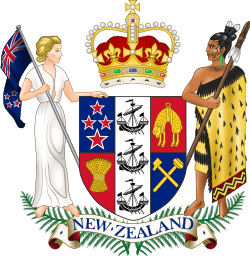Māori Land Court
 |
| This article is part of a series on the politics and government of New Zealand |
| Constitution |
|
|
|
|
Related topics |
The Māori Land Court (Māori: Te Kōti Whenua Māori) is the specialist court in New Zealand that hears matters relating to Māori land.
The Māori Land Court was established in 1865 as the Native Land Court of New Zealand under the Native Lands Act.[1] As outlined by Williams, "government policy from 1858 onwards ... sought to introduce a rapid individualisation of ancestral Maori land in order to ensure the availability of most of that land for settlement by Pakeha settlers".[2] A continuation of the native land policies of 1862,[3] the intention outlined in the Preamble of the 1865 Act was “to encourage the extinction of such [native] proprietary customs”. One means of fulfilling this intention was to limit to ten the number of owners able to be issued a Certificate of Title.
The court caused major ructions within some iwi as the court gave a democratic power to ordinary Maori that previously had been the domain of chiefs only. Judges often heard weeks of oral evidence to prove a claim to the land. Judges were totally independent from the government and their decisions were binding on the government. Judges often made their own rules as points of law arose but the general principle was equity. One of the most dramatic cases was the claim of Ngati Mutanga for their previous land in North Taranaki in 1870. The entire iwi abandoned the Chatham Islands (which they had invaded in 1835) to come to the court hearing.[4]
The court encouraged Maori to sell land to private buyers. But the Crown remained the biggest purchaser. Most Maori owned land was sold during the economic recession of the 1890s. 2.7 million acres was sold to the government and 400,000 acres to private individuals. The Native lands (Validation of Title)Act 1892 was passed by the Liberal government to stop any type of fraudulent deals and to give security of title to purchasers. The act guaranteed Maori a reasonable price for their land. The government on-sold most of its Maori land, often for a profit. The rational behind the legislation was to unlock under used land owned by Maori ( and also pastoralists with vast landholdings) and sell it to "thrifty , hardworking industrious and independent hardworking individuals." [5] The Liberals saw this as essential economic development. By 1939, almost 100 years after the Treaty was signed, Maori retained just 1 percent of the South Island and 9 percent of the North Island. Land losses continued as the 20th century progressed, again supported by legislation.[6]
In 1954, the name was changed to the Māori Land Court. Originally the court was established to translate customary Māori land claims into legal land titles recognisable under English law. In 1993, the Te Ture Whenua Māori Act [7] expanded the court's jurisdiction to allow it to hear cases on all matters related to Māori land.
Appeals from the Māori Land Court are heard by the Māori Appellate Court, which consists of a panel of three judges of the Māori Land Court. The Māori Land Court or the Māori Appellate Court may request an opinion on a matter of law from the High Court of New Zealand; such decisions are binding on the Māori Land Court. Appeals from the Māori Appellate Court, if permitted, lie with the Court of Appeal, and from there to the Supreme Court.
The court has no centralised courthouse but has a head office in Wellington and sits in various cities and towns in New Zealand as needed. The court maintains registries in Whangarei, Hamilton, Rotorua, Whanganui, Hastings, Gisborne, and Christchurch. It also has information offices in Auckland and Turangi.
References
- ↑ "The Native Lands Act 1865". Retrieved 28 December 2011.
- ↑ Williams, David Vernon (1999). 'Te Kooti Tango Whenua: The Native Land Court 1864-1909. Wellington, New Zealand: Huia. p. 82. ISBN 1-877241-03-2.
- ↑ "The Native Lands Act 1862". Retrieved 28 December 2011.
- ↑ Maori Claims and Reinvented Histories. M. Belgrave. 2005 p190-205.
- ↑ The Canoes of Kupe>R.McIntyre. Fraser Books. Masterton. 2012 .pp 125-126.
- ↑ http://www.tepapa.govt.nz/WhatsOn/exhibitions/SliceofHeaven/Exhibition/Maori/Pages/Landrights.aspx
- ↑ "Te Ture Whenua Maori Act 1993". Retrieved 21 December 2011.
Further reading
- Tom Bennion (1997). The Maori Land Court and Land Boards, 1909 to 1952. (Wellington: Waitangi Tribunal).
- Richard Boast (1999). Maori Land Law. (Wellington: Butterworths).
- Dean Cowie. (1996). Land Alienations via the Native Land Court from 1866 to 1873. In Rangahaua Whanui District 11B: Hawke's Bay (pp. 61–136). (Wellington: Waitangi Tribunal). Retrieved from Tribunal website
- Alan Ward (1999). An Unsettled History: Treaty Claims in New Zealand Today. (Wellington: Bridget Williams).
- David Williams (1999). Te Kooti Tango Whenua: The Native Land Court 1864-1909. (Wellington: Huia).
- Joe Williams (2001). Maori Land Court: A Separate Legal System? (Wellington: NZ Centre for Public Law).
External links
- Māori Land Court : official website
- Important Judgments: Delivered in the Compensation Court and Native Land Court. 1866–1879 Compilation of important early cases.
- http://www.tepapa.govt.nz/WhatsOn/exhibitions/SliceofHeaven/Exhibition/Maori/Pages/Landrights.aspx